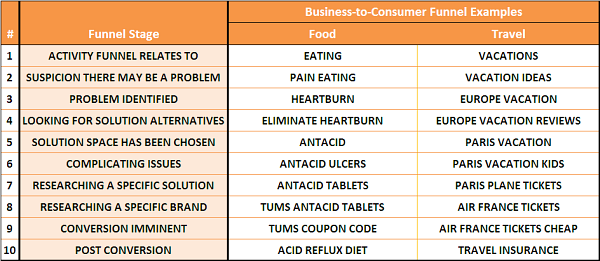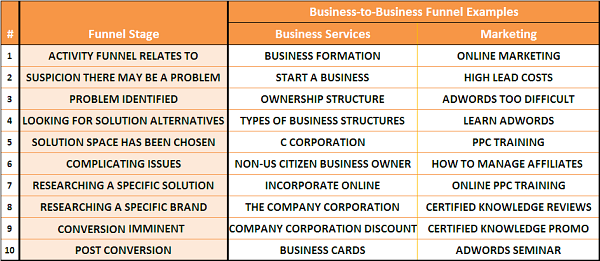How To Use The Keyword Funnel To Understand Searcher Intent
Keyword research can give you great insight into customer problems, needs, desires, and intent.I like to categorize keyword categories themselves into a total of *ten* funnel stages. After performing my initial keyword categorization (sort of into micro-categories), I like to categorize the categories themselves into a total of *ten* funnel stages I've developed, which are organized around a "problem/solution" mental model.
Keyword research can give you great insight into customer problems, needs, desires, and intent. Categorizing the keywords you’ve found is an important step in putting together potential campaigns and deciding on which ones are worth pursuing in your organic or paid search efforts.
I believe that categorizing keywords into the finest groupings that make semantic sense is the right way to do it; often I’ll have a category with 2, 10, or perhaps 30 keywords at the most. Later, when some of the categories are turned into actual campaigns, this tight organization and relevance will tend to pay off with higher quality scores.
Since Google Adwords takes into account the relevance of keywords to the creative, obviously grouping very diverse keywords will result in low relevance, so this is why relatively fine categorization is important.
Often, however, I find myself with too many keywords to handle; even as little as 5,000 keywords broken down into 300 categories, for instance, is still not a very manageable set.
In these cases, I like to take the keyword categories and bundle the categories themselves into a *secondary* category that represents the “funnel” stage that the keyword category belongs to.
Marketers are told to think of a customer as being in one of various “funnel” stages at any given time, and even if you’re not systematic about it, you probably already think of brand terms as being “lower funnel” and research-type terms as being “upper funnel”.
Most readers are doubtless familiar with models such as “Attention-Interest-Desire-Action”, and other 4, 5, and 6 stage funnels which are pretty standard fare for marketers.
After performing my initial keyword categorization (sort of into micro-categories), I like to categorize the categories themselves into a total of *ten* funnel stages I’ve developed, which are organized around a “problem/solution” mental model.
In Figure 1, I’ve shown individual keywords belonging to each funnel stage for a variety of B-to-C funnels. Later, Figure 2 presents some B-to-B examples.
These keywords presented could be actual keywords, but I think they are more appropriately thought of as representing *categories* of keywords:

Figure 1 - Business to Consumer Search Funnel Stages
Ten stages may seem like a lot of detail, but organizing keyword categories into these stages:
- Forces you to really try to understand searcher’s intent.
- Gives you a sense of where the holes in your keyword research are from a funnel perspective.
- Resonates with clients or management and is a great way to discuss and understand a business.
For example, after going through this exercise with one client, to my great surprise, they told me that stage 2 (“Suspicion There May Be a Problem“) was almost the sole focus of their existing marketing.
Their strategy is to pull in searchers looking for help identifying their problem, establishing them early as a trusted brand in the eyes of the searcher. This client has found that organic and offline conversions then naturally follow. Although very much a one-trick pony approach which I would not recommend for most businesses, it works great in their market.
Below is another version of the funnel with examples that are more B-to-B oriented, for those interested in that perspective; we’ll now run through the funnel stages, explain the thinking behind each of them, and discuss which stages you should consider addressing in your marketing mix.

Figure 2 - Business to Business Search Funnel Stages
Activity Funnel Relates To
This is a very general field of activity, and will often not be a focus of marketing efforts since the customer may not actually be experiencing a problem yet.
However, display advertising that targets field-focused websites or is demographically targeted may be a useful vehicle from a branding perspective in this stage.
Suspicion That There May Be A Problem
This funnel is focused around the mental model of problem-solving; other mental models may make for useful funnels as well, but I’ve found “problems” to be universally applicable.
In this stage, there may be symptoms described but the customer does not understand the nature of the problem, or perhaps they don’t even understand that the symptoms are a problem at all.
It’s a critical stage where you can have great influence on the direction a potential customer will take; we’ll touch on this more later.
Problem Identified
This is an interesting bucket because you may have some latent versus blatant needs that you can separate out; different types of problems may actually fork off into different funnels.
Looking For Solution Alternatives
In this stage, the prospect is trying to understand the variety of approaches available to them. There are many ways to lose weight for instance; diet, exercise, portions, surgery, and so on.
This is fairly early in the research phase and can be ripe fruit for thought leadership content (great for the SEO channel as well). If you’re really lucky and you’re the only solution to a problem (perhaps you’re in a new market) then this stage may barely even exist and prospects may jump directly from stage 3 to stage 5.
Solution Space Has Been Chosen
In this stage, the prospect has decided on a particular approach for solving the problem (for instance, “dieting” to solve a weight problem).
Complicating Issues
This stage perhaps belongs alongside the funnel, but I usually place it in the middle of the research phase. Many people with problems have complicating issues; diabetes (if they are interested in weight loss), a wheelchair-bound spouse (if they are interested in travel), and so on.
Addressing these complicating issues can be a great way of differentiating your product or service and reducing friction for a final sale.
Researching A Specific Solution
Now the prospect is getting *very* specific about a particular member of the solution space (“Low-Carb Diets” in the case of a Weight Loss/Dieting funnel for instance).
Researching A Specific Brand
At this stage, the prospect is getting very serious and is educating themselves about specific providers.
Remember, brand terms are well known in the industry to convert at a higher rate as generic terms (twice the rate on average in my experience), so addressing this funnel stage should be a critical component of any online marketing effort.
Conversion Imminent
Terms that include phrases like “coupon code”, “pricing”, “cheap”, are akin to flashing red lights with a siren screaming “transaction about to occur!!!”
Spending a lot of time building out variations in this funnel section is usually well rewarded. Google Suggest is a great place to find ways that potential customers are raising their hands in these ways.
Post Conversion
Often, a neglected funnel stage, this is where you will find customers searching for things like “repairs”, “replacement parts”, “add-ons”, “upgrades”, “warranties”, and “support”.
You may or may not have offerings that address concerns in this funnel stage, but it’s important to think about them.
If you’re a travel company, trip insurance may not be something your customers will actively seek out often, and paid search campaigns targeting that concept may not be worthwhile.
If, however, your paid search keyword research turns up the concept, and you then prompt your company to put together some sort of revenue-sharing deal with a trip insurance provider to integrate their product into your cart, I would say the time spent researching funnel stage #10 was well worth it.
Which Stages Should You Target?
As most articles you’ve read on this topic probably state, you should target all of them. This is not very helpful advice though – often in marketing we have to prioritize our efforts.
If I absolutely had to prioritize the top ones to focus on initially, I would say #9, #8, #5, and #2 in that order.
Funnel Stages #8 and #9, “RESEARCHING A SPECIFIC BRAND” and “CONVERSION IMMINENT” are self-evidently critical; how are you going to leverage this great funnel if you don’t catch potential customer at the end of it?
I am, however, a big believer in avoiding cannibalization from organic search conversions, so my preference is to consider targeting competitor brand terms before I would work on cannibalizing my own.
Funnel Stage #5, “SOLUTION SPACE HAS BEEN CHOSEN” is square in the middle of the research phase, and catches customers who are partially educated on the problem and are still early enough in the funnel to nudge in your direction.
Funnel Stage #2, “SUSPICION THERE MAY BE A PROBLEM” is important because it’s an opportunity for you to disturb the prospect’s equilibrium, a critical step in any sales process.
Much like Don Draper stated in his famous “Carousel” pitch about the term “new”, with problem defining keywords, you “create an itch, and simply put your product in there as a sort of ‘calamine lotion'”. Funnel step #2 is essentially the “itch” stage.
This stage, where the potential customer suspects but does not yet fully understand that they may have a problem, is a powerful leverage point for influencing searchers in your direction. Think of searchers as meteors, heading for earth – a slight nudge much earlier in their trajectory can have as much influence as a strong shove later in the funnel.
Conclusion
Very fine categorization of keywords can be helpful in ascertaining customer intent, organizing your efforts, and suggesting actual paid search campaigns you might run.
I have found these ten funnel stages in particular are a convenient and useful way for me to organize very large numbers of refined categories of keywords, derive insights from them, and create campaigns targeting various phases of the sales funnel.
If anyone has any other useful mental models for constructing a funnel besides the “problem/solution” approach I’ve presented here, or any thoughts on which funnel stages to prioritize and how – by all means, comment below.
Contributing authors are invited to create content for Search Engine Land and are chosen for their expertise and contribution to the search community. Our contributors work under the oversight of the editorial staff and contributions are checked for quality and relevance to our readers. The opinions they express are their own.
Related stories
New on Search Engine Land